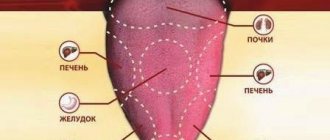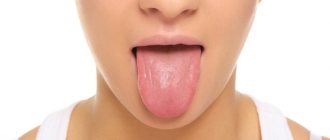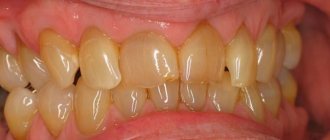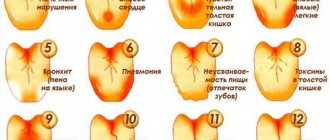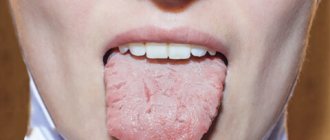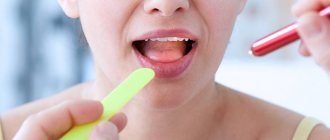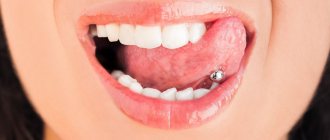- Why do you need to clean your tongue?
- How to clean your tongue
- How to clean your tongue
For many people, oral hygiene ends with brushing their teeth. However, cleaning your tongue is also necessary and important. Plaque and bacteria accumulate on it, from which caries develops and an unpleasant odor appears.
Regular tongue cleaning helps to avoid diseases such as stomatitis, gingivitis, caries and even periodontitis. Now we will look in detail at why you should clean your tongue and how to do it correctly and effectively.
Why do you need to clean your tongue?
Brushing your tongue twice a day not only cleanses it of bacteria. This cleaning eliminates four problems.
- Prevents the development of caries
by preventing microorganisms from producing acid that destroys enamel. - Removes bad breath
because bacteria do not produce odorous substances. - Removes plaque
- a breeding ground for bacteria. - Increases the sensitivity
of taste buds - a clean tongue senses the flavors of food and drinks more clearly.
When caring for your tongue, it is worth remembering that not every coating is a sign of some problems. There is also a healthy plaque that can be easily removed with proper hygiene.
Healthy plaque
can be easily distinguished by several signs.
- It is formed
in the morning, after eating or during thirst; - disappears
after cleansing; - changes color
due to coloring by products; - through it you can see
the surface of the tongue; - it doesn't smell
.
Unhealthy plaque can be a symptom of many health problems: diseases of the stomach and intestines, dysfunction of the liver and kidneys, infections in the body (whooping cough, foot and mouth disease, scarlet fever, pityriasis rosea), as well as a consequence of taking antibiotics.
This is what characterizes an unhealthy plaque
.
- It remains
even after thorough cleaning; - It smells
bad ; - very dense and quickly restored
after cleaning; - regardless of food, the color ranges
from yellow to brown; - accompanied by
redness, swelling and cracks of the tongue, nausea, bitterness in the mouth, gastrointestinal upset, etc.
If the plaque is deep yellow or gray-yellow, you should pay attention to the gastrointestinal tract - you may have gastritis, ulcers, pancreatitis. And if frequent and severe heartburn occurs, the plaque will turn yellow-orange.
But we must remember that harmful plaque is not always caused by some disease. It can appear due to an unhealthy lifestyle: smoking, a large amount of dyes in foods, poor hygiene, even due to caries and bleeding gums. Brushing your tongue with a toothbrush will not solve this problem - you need to contact a specialist to understand how to proceed.
Near and distant prospects
Experts can even determine smoking experience by appearance. If only a whitish coating is noticeable in a novice smoker, then in experienced smokers the coating becomes thicker and changes its color to brown.
Gradually, bacteria, protozoan microorganisms and viruses appear on the tongue of such people.
Stages of transformation of the oral mucosa during smoking:
- a primary burn is characterized by the death of the surface layer of the epithelium - it is for this reason that a white coating appears;
- then the mucous membrane dies off, it is already deep and irreversible - the reason for the appearance of yellow or brown plaque.
The second phase indicates disruptions in the functioning of the oral mucosa: sensitive, protective and motor functions disappear.
Smokers with experience that the language has not only changed in appearance, but has even become different in sensation. Such people claim that the organ “has become wooden.” "doesn't listen." This indicates a violation of speech articulation due to the constant influence of nicotine on the tongue muscle.
And from the smoker’s mouth, in turn, comes a persistent unpleasant smell of tobacco. It also develops a large number of harmful microorganisms, protozoa and viruses. When exposed to so many organisms, the oral mucosa becomes unable to perform its functions.
How to clean your tongue
Do not use regular toothbrushes for cleaning - they will not be able to remove plaque. It is better to pay attention to special tongue cleaning products.
Scrapers
The most common devices are scrapers. The tips of the scrapers are made in the shape of a spoon. They are usually made of plastic, sometimes with stiff bristles. The flat shape prevents the gag reflex that may occur when brushing the root of the tongue. This scraper needs to be changed every six months.
Irrigator attachments
Tongue attachments are also made in the form of a spoon. The irrigator, unlike a conventional scraper, delivers a stream of water, which additionally washes the surface of the tongue.
Attachments for electric brushes
Most brush manufacturers offer special attachments for their products to clean tongue deposits. As a rule, they have a flat, textured rubber surface.
Tongue gels
You should not clean your tongue with toothpaste - it is intended for teeth. Pastes contain abrasives and menthol, they can irritate the mucous membrane. Special gels that gently dissolve plaque and also disinfect the oral cavity are better suited for the tongue.
Can a smoker get tongue cancer from smoking?
When smoking, the tongue is the first organ to take the hit of nicotine. With constant smoking, the organ receives microtraumas, which increase over time. Also, other formations that can develop into cancer may appear on the mucous membrane due to tobacco smoke.
IMPORTANT! Tongue cancer is dangerous because it can only be diagnosed in late stages, and it develops rapidly.
The first signs are the appearance of ulcers and seals. At the beginning of the disease, ulcers and seals have clear boundaries, but as it progresses, the boundaries are erased, and the edges rise upward and resemble rollers in appearance.
Over time, the smoker develops pain, swelling of the face, and difficulty opening the mouth and, accordingly, eating.
Uvula body cancer
The most common type of oncology. The malignant neoplasm affects the middle of the tongue, as well as its lateral parts.
Tongue root cancer
Root damage is characterized by severe pain when swallowing food. This type of oncology is less common compared to the previous one.
The disease also has a second name - oropharyngeal cancer. In this case, the tumor is located at the back of the mouth.
The pathological process is aggressive and treatment is extremely rare.
Cancer of the lower part of the uvula
The pathology is characterized by the presence of a tumor on the lower part of the uvula. In rare cases - under the tongue.
Experts consider three types of neoplasms on the tongue:
- Ulcerative. The disease begins with the appearance of a lump that develops into an ulcer. In this case, the ulcer bleeds almost constantly, and the patient feels severe pain.
- Infiltrative. The tumor that appears in this case is solid. And she herself is covered with white spots. The patient complains of severe pain in the affected area.
- Papillary. The tumor is hard, rises above the rest of the tissue, and is characterized by dense plaques.
How to clean your tongue
If you don't have any health problems that affect the plaque, just follow these guidelines and remember to brush until all the plaque is removed and your tongue is pink again. Typically, tongue hygiene takes only 20–30 seconds.
Recommendations for adults
- Proceed with the procedure only after brushing your teeth
and rinsing your mouth. - Use special tools
: scrapers, nozzles and others. - Clean your tongue using sweeping movements
and light pressure. - Start from the root of the tongue
and end with the tip. - Do not brush your tongue with cross movements and do not press
too hard - this can damage it. - Don't forget to clean the instrument
after the procedure. - Be sure to rinse your mouth
with water.
Should children have their tongues cleaned?
Children also need tongue care, but not earlier than 3–4 years.
For younger children, tongue cleaning is pointless. They don’t eat junk food, especially not in the same quantities as adults, and they don’t drink tea and coffee. Until 3–4 years of age, normal oral care is sufficient. From 3–4 to 8 years
This is how you should clean your tongue.
- Move from the root of the tongue to the tip
with smooth sweeping movements, with even weaker pressure than with adults. - Similarly, clean the sides
of the tongue and the inside of the cheeks. - Be sure to rinse your mouth
.
From the age of 8
you can already use scrapers.
What dangers can plaque and untimely removal pose for a smoker?
We have already said that plaque is not only unsightly, but also dangerous. The formation of plaque indicates tissue destruction, and therefore a deterioration in the functionality of the organ. Its main function is taste sensitivity and transmission of further signals to the brain. If no signals were received, the body did not understand that the digestion process should begin. It is for this reason that digestive problems occur.
Also, plaque in a smoker is a sign of the presence of viruses and microbes that, with saliva, enter the internal organs through the mucous membrane. All harmful microorganisms continue to multiply in the body, disrupting the functioning of each organ separately.
Etiology
To determine what caused the change in tongue color, it is necessary to distinguish the appearance of color from the effects of food or from various internal ailments. If staining occurs due to food, it can be easily removed with a toothbrush, after which it will no longer form. Depending on the reasons, the tongue takes on a different color. Thus, a yellow coating on the tongue appears in the following cases:
- from various liver pathologies, for example, hepatitis of a viral, alcoholic or toxic nature;
- liver cirrhosis – in which the cells of this organ die;
- disruption of the structure of the biliary tract - occurs due to the formation of stones or cancerous tumors;
- suprahepatic jaundice - this occurs due to the fact that the human body does not have time to excrete bilirubin;
- stomach upsets or duodenal ulcers;
- chronic gastritis;
- duodenitis - reflux of the contents of the duodenum into the stomach;
- acute inflammation of the pancreas;
- a wide range of intestinal diseases arising from the actions of bacteria;
- infectious diseases accompanied by high fever and dehydration;
- the influence of parasites on the structure and functioning of the gastrointestinal tract;
- use of certain medications;
- inflammatory processes of the tongue - glossitis.
A yellow coating on a child’s tongue appears for the following reasons:
- jaundice in a newborn;
- feeding your baby foods that color his tongue. Among them are carrots, pumpkins or apricots;
- addiction to sweets, which often change the color of the tongue.
In other cases, children are characterized by similar factors causing yellow or white-yellow plaque.
A brown coating on the tongue is formed when:
- nicotine abuse. Often, long-term smokers' tongue takes on just this shade;
- taking large amounts of caffeine-containing products. This also includes chocolate, strong black tea, and carbonated drinks. It is because of this that a brown coating on the tongue most often occurs in children;
- treatment with drugs containing high iodine content;
- severe dehydration;
- disorders of the gallbladder;
- fungal diseases of the oral cavity;
- comatose state with diabetes;
- lack of iron in the body;
- stomatitis - in this case, in the initial stages the tongue will have a white-brown color, but the more the disease develops, the darker the coating on the tongue will be;
- disorders of the intestinal microflora.
Such a strange green coating on the tongue indicates problems with the liver. The following factors lead to this:
- eating foods that are too fatty in large quantities;
- consequences of taking certain antibiotics;
- a wide range of diseases of the gastrointestinal tract;
- fungal infections. The stronger the pathogenic process develops, the brighter the green coating on the tongue will be;
- HIV infection;
- thrush.
A greenish coating can cover both the entire area of the organ and a certain part of it; the back part is often covered with this color. If you don’t change your diet, the coating will change from white-green to deep green.
Black plaque on the tongue appears for a number of reasons:
- eating berries with a specific color, for example, mulberries or blueberries;
- taking a drug such as activated carbon for treatment;
- alkaline balance disorders, when a person eats a lot of flour, but few fresh fruits and vegetables;
- intoxication of the body, in particular lead poisoning;
- various disorders of the digestive system;
- prolonged effects on the body of high temperature during colds;
- fungal infections lead to the appearance of black plaque on the tongue and tooth enamel;
- thrush - this disorder is characterized by the appearance of a white coating, but in advanced stages it becomes black;
- alcohol abuse;
- slagging of the body.
Depending on the stage of a particular disease, the tongue becomes covered with black dots or is completely coated. A black coating on a child’s tongue occurs during the first complementary feeding after breastfeeding and is due to the fact that the body was not prepared for this process.
A gray coating on the tongue can form against the background of:
- inflammatory processes of the respiratory system. After recovery, the tongue takes on its natural shade;
- taking antibiotics or hormonal medications for a long time;
- diseases of the oral cavity. A white-gray coating on the tongue occurs only in the morning and does not recur throughout the day after oral hygiene;
- reduced immunity – with chronic diseases;
- insufficient amount of fluid in the body;
- tonsillitis;
- HIV. At the same time, a gray coating on the tongue does not always indicate the presence of this disease, but in some cases it is one of the symptoms.
Diagnostics
Diagnosis of plaque on the tongue consists in determining the reason due to which this symptom began to be expressed. When first examining a patient, the doctor pays attention to:
- shade. The darker a particular color, the stronger the pathological process develops, which is why you need to visit a doctor the first time you notice a change in the normal shade of an organ;
- thickness of plaque and its localization. For diagnosis, it is very important whether the tongue has acquired a completely unhealthy connotation, or only part of it;
- the relief of this organ and its motor functions;
- the presence of additional diseases in the oral cavity.
After this, the patient is prescribed:
- additional hardware examinations to detect internal inflammatory or infectious diseases;
- urine and blood tests. A stool sample is taken to confirm the presence of helminths or other parasites.
After all the examinations, the doctor will prescribe individual ways for each patient to remove plaque from the tongue.
Treatment
Therapy for yellow plaque on the tongue consists of prescribing to the patient:
- drugs to increase bile flow;
- substances that restore the structure of the kidneys;
- antiviral medications;
- antibiotics and antifungals;
- solutions for the treatment of dehydration;
- vitamin complexes.
Depending on the factors of manifestation, treatment for brown plaque on the tongue consists of:
- dietary changes;
- antifungal medications;
- medications high in vitamin B.
Therapeutic measures for green plaque on the tongue include regular oral hygiene. If there is an intense unpleasant odor, use an antiseptic solution. In cases where this does not help, it is necessary to adjust the diet.
Therapy for black plaque on the tongue is based on:
- regular oral hygiene;
- limiting the intake of toxins and dyes into the body;
- increasing the amount of water consumed.
To eliminate gray plaque on the tongue you need to:
- take antibiotics and drugs against viruses and bacteria;
- consume less table salt;
- medicines that strengthen the body.
But these are only general means of how to get rid of plaque on the tongue. For infectious and viral diseases, as well as disorders of internal organs, therapy will be more profound and individual in nature.
Smoker's plaque is a pigmented plaque that forms on the enamel of the teeth of smokers. Characterized by a dense, viscous structure, it penetrates deeply into tooth enamel and colors it in a characteristic yellow, brown or black color. Accumulating on the neck of the tooth and in hard-to-reach places not involved in the chewing process, plaque from smoking is difficult to remove and provokes the occurrence of dental diseases.
How plaque forms
Tobacco tar and nicotine are deposited primarily on the teeth. The finely porous surface of the enamel promotes the rapid “attachment” of combustion products and gradually loses its natural color.
Teeth do not immediately become “black” (a common expression). First, the enamel tarnishes with the formation of a yellow coating, then it acquires a darker color, and only after that a noticeable brown pigment appears in the form of spots and stripes.
The process of plaque formation on teeth from smoking lasts more than one day. Microscopic food debris, saliva and tobacco tars gradually form a very strong chemical complex that is difficult to remove with a toothbrush and other means at hand. At first, whitening pastes can help, but over time they stop working.
Phosphorus and iron salts contained in saliva, when interacting with tobacco tars, actively deposit first on the root part of the tooth. A smoker’s smile is immediately visible - the main part of the plaque is concentrated in this place. In particularly advanced cases, teeth change color almost completely.
Smoker's plaque is the first step to the formation of stones, which can only be removed in the dentist's office.
Removing plaque using folk remedies
Traditional medicine does not stand aside from dental problems. And to eliminate smoker’s plaque, she suggests using the well-known baking soda. To do this, you need to mix it with tooth powder or toothpaste and clean your teeth very thoroughly with this mixture. But it must be taken into account that this mixture can be used no more than 2 times a week, which is clearly not enough to remove cigarette stains. Otherwise, baking soda will gradually soften tooth enamel and negatively affect the condition of your gums. Often after such an “execution” there appears profuse bleeding of the gums and increased sensitivity of the enamel, which begins to react painfully to “cold” and “hot”.
There is also a safer method of traditional medicine that allows you to remove smoker’s plaque. To do this, immediately after smoking a cigarette, you need to chew a slice of lemon, green apple or strawberry for a long time. The fruit acids contained in these products will prevent plaque formation. But at the same time, they have a destructive effect on tooth enamel and cause its gradual thinning. And it is unlikely that any smoker will decide to undertake such a complex “ritual” after each cigarette smoked.
Professional teeth cleaning from plaque
At the Dental Center on Shabolovka, professional teeth cleaning is carried out to effectively remove smoker’s plaque. To do this, one of the modern methods of teeth cleaning can be used.
- Mechanical cleaning
- the procedure is carried out manually, using ultrasound or Air-Flow and is reduced to the mechanical destruction of plaque and stone. - Chemical cleaning
is a procedure that involves the application of special dental solutions that soften and break down plaque and tartar, allowing them to be removed from the surface of the teeth. - A combined method
is a procedure that includes chemical and mechanical cleaning of teeth, thanks to which you can achieve the best visible result.
Once the smoker's plaque has been removed, the dentist will grind and polish the surface of the teeth, which will significantly reduce the rate at which the problem reappears.
Important to remember!
The popular teeth whitening procedure is carried out only after professional cleaning.
Preventing smoker plaque
The only 100% effective prevention of the appearance of yellow plaque is a complete cessation of smoking. But even in this case, a person needs to undergo professional teeth cleaning to get rid of plaque, since it will not go away on its own. The resulting plaque remains for life and can gradually “grow”, involving clean areas of enamel in the inflammatory process.
If a person’s plans do not include giving up cigarettes, then regular teeth cleaning at the dentist is all the more necessary. After it is completed, he will receive useful recommendations that will help slow down the process of formation of yellow-brown plaque. These could be the following activities:
- Reduce the number of cigarettes you smoke daily.
- Use preventive toothpastes and rinses.
- Use special whitening gels in a controlled manner.
In addition, you will need to regularly visit the dentist and undergo preventive examinations.


